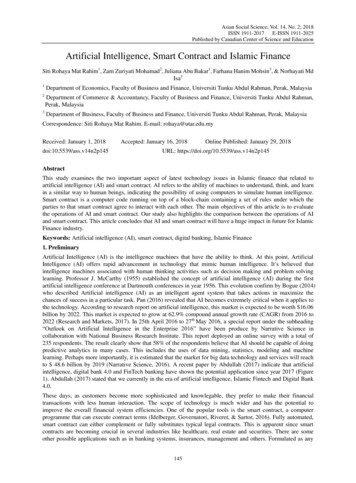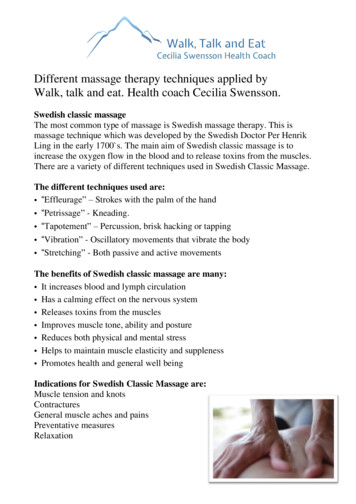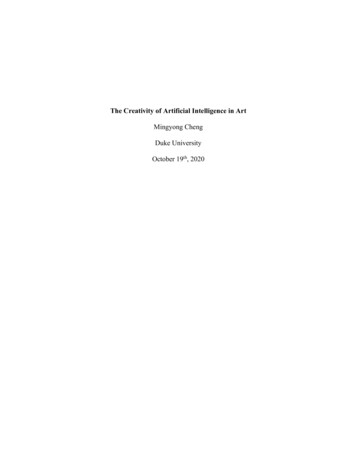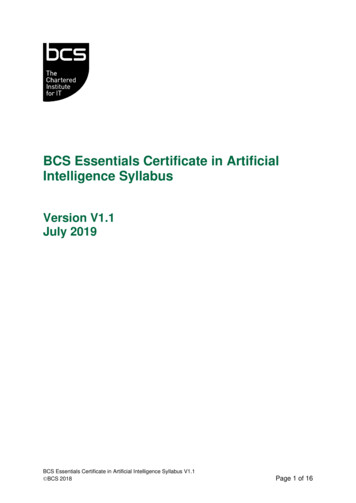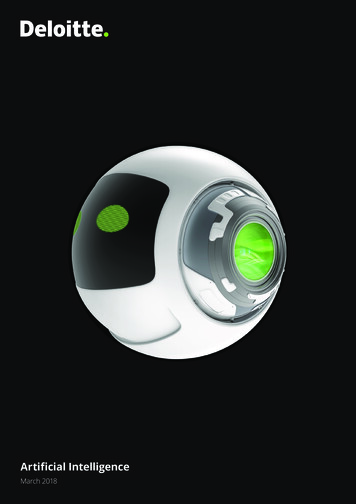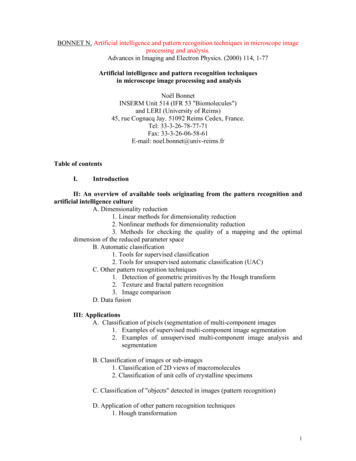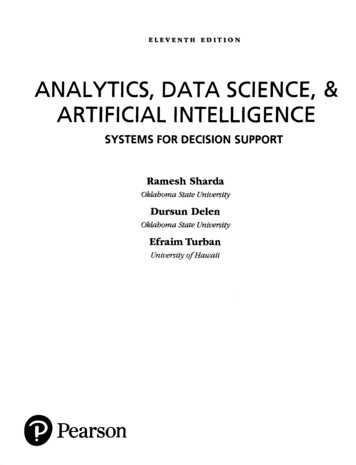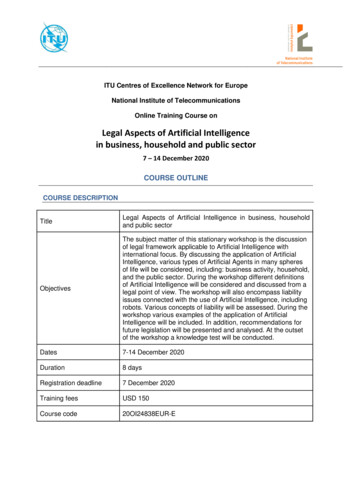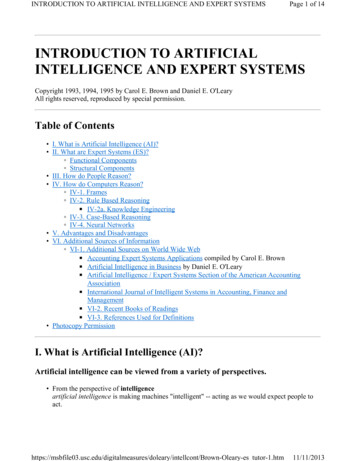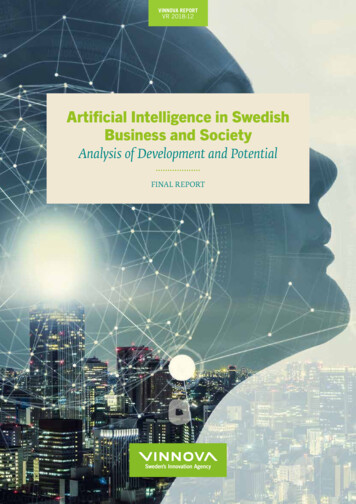
Transcription
VINNOVA REPORTVR 2018:12Artificial Intelligence in SwedishBusiness and SocietyAnalysis of Development and PotentialFINAL REPORT
Title: Artificial Intelligence in Swedish Business and Society – Analysis of Development and PotentialAuthor: VinnovaSeries: Vinnova Rapport VR 2018:12ISSN: 1650-3104ISBN: 978-91-87537-79-0Published: May 2018Publisher: Vinnova - Sweden s Innovation AgencyRegistration no.: 2017-05616Production & layout: Vinnova CommunicationsShort about VinnovaOur vision is to strengthen Sweden as a country of research and innovation.Vinnova’s vision is for Sweden to become a leading global player in research andinnovation, and a country that is attractive for investment and entrepreneurship.Vinnova is Sweden’s innovation agency. Our mission is to contribute to sustainablegrowth by improving the conditions for innovation. We do this mainly by fundinginnovation projects and the research needed to develop new solutions. We also investlong term in strong research and innovation environments.We stimulate collaborations between companies, universities and other highereducation institutions, public services, civil society and other actors. Our activities alsofocus on strengthening international cooperation.Each year, Vinnova invests around SEK 3 billion in fostering innovation. Most of thesefunds are allocated via calls for proposals in which companies, public sector actors andother organisations apply for funding. All investments are continuously monitored andevaluated and we regularly analyse the impacts of our investments.Vinnova is a government agency under the Ministry of Enterprise and Innovation,and the national contact authority for the EU Framework Programme for Researchand Innovation. We are also the Swedish Government’s expert authority in the area ofinnovation policy. Vinnova employs just over 200 people and has offices in Stockholmand Brussels. Acting director general is Leif Callenholm.The Vinnova Report series includes evaluations, analyzes and reports about ourprogrammes, funded projects or assignments we’ve given others.Vinnova s publications are published at vinnova.se
Artificial Intelligence in SwedishBusiness and Society– Analysis of Development and PotentialFINAL REPORTGovernment commission to conduct mapping and analysis of the effective application ofartificial intelligence and machine learning in Swedish industry and in Swedish societyRef. no. 2017-05616N2017/07836/FÖF
Table of ContentsPreface 5Summary analysis 61Introduction 242Artificial Intelligence 252.1What is artificial intelligence? .252.2Driving forces and conditions for artificial intelligence .283Growth scenarios 303.1Growth potential in AI applications .303.2AI potential in different industries and sectors .324Sweden’s AI potential in business 364.1Company surveys and interviews .364.2SWOT analyses from Strategic Innovation Programs (SIP) .455Sweden’s AI potential within the public sector 565.1AI in the public sector.565.2Strategy, governance and leadership .625.3Competence .635.4Adjustment and innovation capacity .665.5Realisation of AI potential within the public sector .676Societal challenges with AI 706.1Job scenarios linked to automation and AI .706.2Societal risks linked to abuse of AI .746.3Regulatory development linked to AI .757Sweden’s ecosystem of companies for AI-related innovation 777.1Swedish participation in patenting within the field of AI .777.2A more complete picture of the ecosystem of companies in Sweden for AI-relatedinnovation .838Sweden’s AI research 888.1The USA dominates the research front but China is quickly gaining ground .898.2Within AI research as a whole, Sweden is relatively weak .938.3Research environments within AI in Sweden .948.4A large and growing part of the AI research relates to applications .988.5Conclusions. 1029Sweden’s AI-related competence 1039.1Competence scenarios and the demand for competence . 1033
9.29.3International comparison of ICT specialists . 106ICT competence in the Swedish labour force . 10810Higher education institutions 11810.1 Globalised knowledge landscape . 11810.2 Development of higher education institutions in Sweden . 12010.3 Challenges for research . 12310.4 Challenges for education . 12411R&D investments in AI in Sweden 12911.1 Swedish Research Council . 12911.2 Vinnova . 13211.3 Swedish Foundation for Strategic Research . 13611.4 The Knowledge Foundation . 13611.5 Knut and Alice Wallenberg Foundation . 13712AI investments in other countries12.1 USA .12.2 China .12.3 United Kingdom .12.4 France .12.5 Canada .12.6 Finland .139139142143145148148References 150Appendix 1. Patent Analysis 154Appendix: Data and Method used in the analysis . 175Appendix 2. ICT-educated individuals in Sweden 177
PrefaceOn 22 December 2017, the Government commissioned Vinnova (N2017/07836/FÖF) to conductmapping and analysis of the effective application of artificial intelligence (AI) and machinelearning in Swedish industry, the public sector and Swedish society and the potential that canbe realised by reinforcing its use. The commission involves: mapping and analysing the potential of using AI and related technologies in Swedish industry inparticular and in Swedish business and the public sector in general, mapping and describing the current position of Sweden within the field of AI, especially in terms ofavailability to and provision of competence through education and further training, but also with regardto research and public initiatives to implement AI in different industries and social sectors, analysing how far Sweden has come in terms of utilising the possibilities of AI and highlightingbottlenecks that may constitute limiting factors for its use.A commission report shall be submitted to the Ministry of Enterprise and Innovation by 30April 2018. Vinnova submitted an interim report to the Ministry of Enterprise and Innovationon 12 February 2018. This report constitutes Vinnova’s final report.Firstly, Vinnova would like to THANK all those who contributed with supportingdocumentation, proposals, opinions and comments during the process of producing this report.The list is long: public actors, business representatives, academia, research institutes, researchfinanciers, strategic innovation programs, trade associations, networks within the AI arena,and many more. A special thanks to Governo, Teqmine, KTH’s bibliometric group, the SwedishResearch Council and Statistics Sweden, all of whom have contributed analysis data incollaboration with Vinnova. In addition to data, Governo has provided an analysis of AI withinthe public sector, and the Finnish company Teqmine has, in addition to patent data, assisted inthe analysis of this data.At Vinnova, Lennart Stenberg, Annika Zika-Viktorsson, Rolf Nilsson, Jonny Ullström, JosefinLundström and David Jonasson have produced data and analysis documentation and have alsoanalysed data and material from many different sources. Cecilia Sjöberg, Erik Borälv, LindaSwirtun and Ulf Öhlander have contributed their essential expertise within the field of AI withregard to the different areas of application for AI, the role of AI in Vinnova’s initiatives, andinternational developments within AI. Hanna Mittjas and Ingelore Djurheden contributedcommunications skills and layout. In addition, many others at Vinnova have contributed withsupporting material, viewpoints and initiatives. Karin Stridh coordinated the governmentcommission and has worked on the report. Göran Marklund was the project manager and hasbeen responsible for the writing of the report.Vinnova in May 2018Göran MarklundDeputy Director General external mattersHead of Operational Development5
Summary analysisThere is no clear-cut definition or generally accepted demarcation of artificial intelligence (AI).In this analysis, artificial intelligence is defined as the ability of a machine to imitate intelligenthuman behaviour. Artificial intelligence also denotes the area of science and technology thataims to study, understand and develop computers and software with intelligent behaviour.The purpose of this analysis is to identify and analyse: Opportunities in the use of AI within business and public services in Sweden. Development to date of Sweden’s use of AI. AI skills for business and public services.A central part of the analysis is to create an understanding of driving forces, opportunities, obstacles and linksbetween significant factors for AI-based value creation in business and the public sector.The issues dealt with by the assignment are wide-ranging, and many different aspects of thedevelopment of business and society are significant in relation to these issues. Accordingly, thisanalysis cannot claim to be comprehensive. This summary describes Vinnova’s assessments andconclusions of the studies, data and expert opinions on which the analysis is based.Sweden’s AI capabilityApplications of AI have already been of great importance for the development of internetplatforms, information retrieval, image recognition and automated translation, but thepractical impact of AI has been limited in large parts of business and in public activities inSweden. However, during the last decade, access to data in electronic form and computingpower has increased very quickly, which has considerably improved the conditions for AIapplications in various activities.Opportunities and challengesIn order to assess the AI potential for value-creation and to use this potential, it is important tounderstand the possible areas of application in various industries, since it is in these that thevalue-creating potential lies. Possible applications also provide the driving force for AIdevelopment in companies and public activities.The potential lies in: Automating functions in established value chains, operations and functions. Developing new business models, products, services and system solutions. Transforming value chains and sectors for brand new development tracks.6
Sweden’s value creation potential in the use of AI within business and public services is great. Mostassessments identify a growth potential that is twice as fast with large AI utilisation in the economycompared with a low AI utilisation.The potential for improved quality and efficiency in the public sector is great. Additionally,there is very considerable potential in developing and implementing AI solutions forenvironmental and social challenges in society. Accordingly, artificial intelligence cancontribute to Sweden’s possibilities of achieving the goals in the 2030 Agenda for SustainableDevelopment.A considerable increase of AI applications in business, the public sector and society has not onlya potential to improve the quality and efficiency in various operations, as well as increasedgrowth and improved welfare; AI developments will also generate new challenges through thedevelopment and adjustment processes that will become necessary. The following challengeswill become important as a consequence of increased AI utilisation: Leadership and adaptability in companies, public operations and policy systems Labour dynamics and unemployment due to rapidly changing job descriptions Data ownership and challenges in relation to privacy, ethics and trust Data and business monopolies for a small number of technology-based companies Risk of application of immature AI solutions based on incorrect data and algorithms Security risks through conscious harmful data usage and data manipulationInnovation leadership in all sectors and at all levels will become very significant for the AIdevelopment in Sweden. The dynamics in the labour market will increase considerably as the AIapplications in business and public operations become more frequent. Adaptability ofindividuals and operations will become increasingly important. This will place very highdemands on leadership skills for business development and the ability to support individuals inreadjustment and upgrading of skills. Therefore, the momentum, skills and other requirementsfor such adaptability must be significantly strengthened.The net effects of labour dynamics for the economy are largely very uncertain. Based on historical developmentand new scenarios, there is no reason to assume, however, that the creation of new jobs will be slower overallthan the pace of the jobs that will disappear.Regulatory developments and the rules regarding data and data access will be crucial for thedevelopment of AI. Such rules must strike a balance between the fundamental needs forprivacy, ethics, trust and social protection and data access necessary for the development ofvalue-creating AI applications. This requires that drivers and competences to participate ininnovation processes are significantly strengthened among public authorities and experts incharge of regulatory and regulatory monitoring. One important aspect is that such publicauthorities and experts should cooperate directly with other stakeholders in the R&D andinnovation processes where new AI applications are developed.7
Leadership and governance for a safe and value-creating transformation of society as a wholemust be strengthened considerably. Knowledge about how increasing AI usage may affect thedevelopment of society and what measures may contribute to minimizing the risks of adverseeffects of AI are deemed highly undeveloped. Competence development in relation to socialaspects of AI therefore needs to be strengthened. The ability to prepare system analyses thatcreate understanding of how different drivers, factors and processes affect each other are verysignificant in this context. However, analyses that form the bases for various policy areas areoften conducted with a systems perspective that is too narrow, linked to specific areas of policyand based on narrow questions. Often, they are also based on a method repertoire for necessarysystems analyses that is too narrow. While initiatives are taken to promote the utilization of AI,research, analytical capacity and processes for system analyses need to be developedsignificantly.Important areasArtificial intelligence will be important for Sweden’s future competitiveness and innovativestrength in all sectors and industry branches, that will all be affected by the development of AI.Therefore, it is difficult to identify areas of application for AI where Sweden is particularly wellplaced. However, the following broad and mutually dependent areas of application for AI areexpected to be particularly important for the development of both Swedish business andsociety: Industrial development - development of products and services and manufacturing and serviceprocesses Travel and transports - autonomous vehicles, logistics and transport infrastructure Sustainable and smart cities - transport systems, energy and waste, education and healthcare systems Health - products, services and processes for diagnostics, drugs, and healthcare Financial services - service development in finance, insurance and payment systems Security - defence, civil contingency, police and customsThe opportunities for AI applications are different in different areas. Many different factors willbe important in the development and these will be strongly mutually dependent on each other.The following factors and the interaction between these will be important in all activities: Business and operational models - for some companies and public operations the value creationpotential of AI is apparent, while others cannot yet perceive a benefit as clearly. Drivers - for some companies AI is already a significant competitive factor, while others still lack cleardrivers, and the drivers are generally weak in the public sector. Data access - in most areas, lack of data access is a crucial limit on the development of business andoperational models are based on AI applications. Competence - limited AI skills in companies and public activities, among both managers andemployees, hampers the development of AI in most operations.Business and operational models, data access and competence are mutually dependent andtherefore heavily affected by each other in companies and public operations. Without clearprospects of business benefits, the drivers of AI-based investments are inhibited. If the businessbenefit is not clear, AI competence is also not viewed as an important factor for value creation8
and efficiency, affecting recruitment patterns and competence development. Limited AIcompetence, at managerial level and among employees, makes it difficult, in turn, to develop AIbased business and operational models. Data access and possibilities of combining differentdata will be fundamentally significant for purposes of identifying the applications that can bedeveloped. Data restrictions that inhibit or eliminate the development of AI-based products andprocesses weaken the drivers for AI investments, Figure 1.Figure 1. Mutual dependencies among important factors for the development of AI applicationsImportant prerequisites for a positive development of the interaction between the above factorswill include: Innovation leadership for the development of AI applications and the ability to lead businessrestructuring and to support individuals in readjustment and upgrading of skills. Labour market models that give individuals drivers and favourable terms for labour dynamics and lifelong learning lay the foundation for continuous adjustment in the labour market. Data regulations for many AI applications restrict the development considerably. Such regulations oftenhave strong links to privacy, ethics, trust and ownership rights. Social solutions for digital security, integrity, ethics, trust and safety, striking a balance between thefundamental needs for data access for AI development and social development needs. Critical mass and international attractiveness in environments for research, education and innovationthat are characterized by efficient cooperation among different functions and market participants. Collaboration among companies, public operations, research institutes, universities and universitycolleges will be crucial in realizing Sweden’s AI potential.Leadership in relation to innovation and operational development will be of crucialsignificance, and there are many indications that requirements in relation to this ability incompanies, public operations, universities and university colleges as well as in political bodieswill increase significantly as the use of AI becomes more frequent. Increased AI applications9
will have a strong impact on job descriptions, labour organisation and the labour market. Thiswill involve significant challenges in leading restructuring or AI-based operationaldevelopment and innovation in companies, public operations and in universities and universitycolleges.Increased AI usage will also place significantly higher demands on individuals to continuouslychange tasks and continuously renew their competence. This in turn will require developmentand adaptation of drivers and social security systems for transitions in working life, presentingnew challenges in terms of labour market policies and for the participants in the labour market.Successful AI development in different areas will depend on both specialist and broadcompetence within AI and domain and organizational competence for different AI applications.Access to data is closely linked with regulatory conditions relating to data and datamanagement. Data regarding individuals and individual behaviour is of crucial significance formany AI applications. Data access is determined by how companies and public operationsdevelop and safeguard data in their operations and collaboration, and by the development ofregulatory conditions for data generation and data access. Therefore, society’s regulatory andethical management of privacy issues, data security and title to data will be very important inthe context of AI development.Internationally strong environments for research, education, and innovation will therefore beimportant for Sweden’s innovative strength and international attractiveness for leading AIcompetence and corporate AI development. Cooperation to achieve a critical mass in suchenvironments will be crucial. Cooperation will also be important to link regulatorydevelopment and labour market development with innovation processes for AI applications. Itis difficult to identify any area that is as dependent on cooperation between differentstakeholders and across sectoral borders as AI. A positive AI development in Sweden thusdemands efficient cooperation among many different actors and functions in society.Sweden’s AI capabilityThere are many different factors that are significant in relation to Sweden’s ability to developand use AI. Different factors also play roles of different magnitude within different sectors anddifferent branches of industry. Table 1 is an overall analysis of Sweden’s Strengths, Weaknesses,Opportunities and Threats (SWOT).10
Table 1 Overall SWOT-analysis of Sweden’s AI capabilitySTRENGTHSWEAKNESSESTechnology-friendly populationHigh level of technological skillsQualified researchers and engineersGood domain competence regarding processesGood data accessAI competence hard to recruitLack of competence for digital business modelsUniversities and university colleges have weak drivers forflexible professional trainingMany SME have limited resources and competenceSlimmed-down organisations hamper competencedevelopmentExcellent IT networksInfrastructure for data trafficMany digitalised processesHigh level of automationIT infrastructure not always accessible and stableIT maturity varies within value chainsLack of coordinated security initiativesAutomation systems are often based on old technologyMajor international technology-driving companiesEfficient public operationsGood innovation abilityAbility to solve complex problemsLong experience in security-critical solutionsUnclear ownership and data rulesUncertainty concerning future data access regulationLack of AI standardsDifficult to cross-check dataFailures in data quality and structureCulture of cooperationDeveloped innovation systemEfficient value chains and ecosystemsAbility to build consortiaFragmented municipal sectorPoor cooperation among county councilsLack of state controlFew and unfocused R&D initiatives in AIOPPORTUNITIESTHREATSIncreased innovation pace with AIUse access to large volumes of dataUse our quality register for AI analysisRegulatory development does not interact with the AIrequirementsPrivacy issues are dealt with differently in SwedenIntellectual property rights could be threatenedNew technical opportunities via system connectionsNew functions and improved quality of products andservicesIncreased efficiency in production and processesSystem potential in new value chain connectionsPoor AI competence at management levelPoor AI competence weakens development momentumRegional differences in AI competenceAI competence leaving SwedenNew work methods and new organisation methodsNew interesting and attractive jobsImproved work environmentFears and unrealistic expectationsLong implementation timelines inhibit investmentLack of AI investments inhibits competitivenessSweden could be a test bed for AI developmentSweden has a high attractiveness level internationallyDevelop cooperation around AI-developmentDevelop cooperation around AI-implementationUse the cooperation capacity of the research institutesThe rest of the world invests more and faster thanSwedenSweden will not become a test bed for new AI solutionsLarge dependence on systems suppliersIncreasing vulnerability in systemsPoor IT security increases social risksTrain existing AI competenceDevelop regulations promoting data accessDevelop policies promoting system developmentSimple jobs are disappearing and unemployment is risingTrust and confidence in the future is inhibited by thedevelopment of AIDistrust as AI failed in the 80s and 90sSwedish society is characterized by a high degree of digitalisation compared to most othercountries. IT infrastructure is well developed and has a high capacity in large parts of thecountry. Digitisation in working life has come a long way in many sectors, while a majority ofthe population is connected to the internet and has a high level of IT experiences. This providesan important basis for Sweden’s AI capability and for a strong development of AI competenceand AI applications.AI competence will be of crucial significance in order to realize Sweden’s AI capability. Whilecomputer science skills are important, access to software engineers will be crucial, since11
successful AI development often requires extensive software development. Access to AIcompetence will be a significant challenge, since there is a global lack of such expertise. AIapplications are expected to increase drastically in the next few decades. Global demand for AIcompetence will therefore increase sharply, which means that an already significant lack of AIcompetence is expected to grow further.How digitisation competence in general and AI competence in particular should be comparedbetween countries is not obvious. In relation to technology and IT competence, Sweden has arelatively good starting position, both for newly graduated and for IT-educated in the labourmarket. This should mean that there are good opportunities for strengthening AI competencein Sweden through competence development of already well-educated technologicalcompetence. However, digital transformation and AI development will change therequirements and conditions for both research and competence development. Technologydevelopment increasingly takes place through interdisciplinary science, i.e. through newconnections between different areas of technology and competence. In this context, establishedprocesses and institutional solutions in research and education are becoming less suitable forthis development.The ability of universities and university colleges in Sweden to adapt the focus of their researchand education to the rapid and multidisciplinary changes that AI generates is poor. There aremany indications that further education must account for most of the education system’sadaptation in catering to the AI requirements of business and society. However, universitiesand university colleges find it difficult to develop and operate bri
In this analysis, artificial intelligence is defined as the ability of a machine to imitate intelligent human behaviour. Artificial intelligence also denotes the area of science and technology that aims to study, understand and develop computers and software with intelligent behaviour.
